The Rise and Fall of the Delicious
And the bastardization of a good thing.
I. The Hawkeye
Outside the lean geometry of Jesse Hiatt’s orchard of Bellflower apples a seedling sprouted in the field margins and he mowed it down. It sprouted again, and again he mowed it. But when the next season saw it rise up towards the Iowa prairie sky once more with a flinty stubbornness the old Quaker recognized in himself he granted clemency, saying “If thee must live, thee may”. Years passed until one autumn the tree burst forth with red and yellow streaked fruit. It had an unusual shape — gently tapered, knuckled on the bottom. When Hiatt took a bite his eyes lit up and he ran into the house and declared “Ma, this is the best apple in the whole world! “
He christened it the Hawkeye in honor of his state. But Hiatt’s revelation was a lonely one. For years, the tree stood like a ragged prophet in his orchard, much loved by the neighbors but ignored by every nursery to which he sent letters.
Two hundred miles south in Missouri, Clarence Stark, the patriarch of Stark Bro’s Nursery, kept a small red notebook filled with names he particularly liked for new apple varieties awaiting discovery. For years the name Delicious rode around in that notebook, awaiting a Cinderella that might revolutionize the apple industry. In 1893, Hiatt shipped four Hawkeyes off to the nursery's annual fruit show. On tasting it Stark yelled “Delicious!”, ate the whole thing, core and all, and declared it the winner of the competition. Unfortunately the tag had been misplaced, and no one knew where the apples had come from.
For a year, the memory of that taste rankled him. When Hiatt sent another shipment in 1894, properly tagged this time, Stark smelled the apples and recognized them even before opening the package. He wrote to the Iowa farmer and secured rights to propagate the tree, patenting it the Stark Delicious. It would indeed revolutionize the apple industry, an industry that would eventually bastardize it into a gleaming insipid Platonic form of an apple, one called the Red Delicious.
II. The Golden Delicious
The Greeks said that at the far western edge of the world was a garden. An orchard, in fact, Hera’s own, tended by nymphs called the Hesperides and guarded by Ladon, a dragon with a hundred heads. The orchard grew golden apples that were said to grant immortality. Ancient sources believed it might be located near the Atlas Mountains, Lake Triton in Libya, or the Canary Islands. But had they known it existed, they might have said West Virginia.
After discovering their red archetype, Stark Bro’s began looking for a golden brother to match. In 1914 the West Virginian Anderson Mullins mailed a box of sweet yellow fruit from a seedling tree that had sprung up on his farm in Odessa. Clarence Stark, a man who clearly recognized destiny when he tasted it, bit into the flesh and said, “Even if it was at the end of the world, we must visit that tree”. He soon embarked on a pilgrimage — a thousand miles by clattering rail, then deeper still into Appalachia on horseback, winding through the coal-stained hills.
He arrived to find a small cluster of apple trees. While most looked ragged and barren, a single tree stood vibrant and strong, boughs genuflecting under the weight of a huge crop of golden apples. Stark ran up the hill with a whoop and bought the tree for a whopping five thousand dollars, a fortune that would surpass $160k today. But anything was worth gaining sole access to the Hesperides' fruit reincarnated in American soil. The nursery began propagating what they dubbed the Golden Delicious and welded a cage around the original tree, a steel dragon to guard Stark’s treasure.
Nearly every named variety of apple — each Baldwin, McIntosh, Winesap — has a rags to riches story of this sort, where some accidental Adam or Eve through blind luck manifests something worth keeping. In America the progenitor tends to have a plaque and a patent. This is a country where mythology necessarily blends with commerce, after all.
III. The Dynasty
With the arrival of the golden brother the Stark Brothers had their matched set. They renamed the original Stark Delicious “Red” to avoid confusion, spent a fortune on marketing both, and the two fruits became a staple in grocery stores from coast to coast.
Apple trees are restless creatures, frequently throwing off sports — mutations that sprout gleefully like hairs in the ears of an aging man. In 1923 a New Jersey grower discovered that one branch on his Red Delicious bore fruit that had turned solid crimson, with no trace of Hawkeye stripes. The Stark Brothers bought that single limb for six thousand dollars. It was the beginning of the end.
What followed was a frenzy of genetic meddling. The marketplace wanted twins that looked the part, one red and one golden, and both flawless. Growers discovered they were paid by redness alone, not flavor, and the race was on for blood-colored fruit. But the genes that painted those stripes happened to interweave with those that conjured flavor, and with each generation selected for deeper red, the soul of the apple withered. Over forty different sports were eventually patented, each one a step further from the taste that made Hiatt run yipping into his kitchen.
The Golden Delicious suffered its own quiet decline, picked increasingly green and unripe to increase the time it could languish on grocery store shelves, until it too became a shadow of its hillside origins.
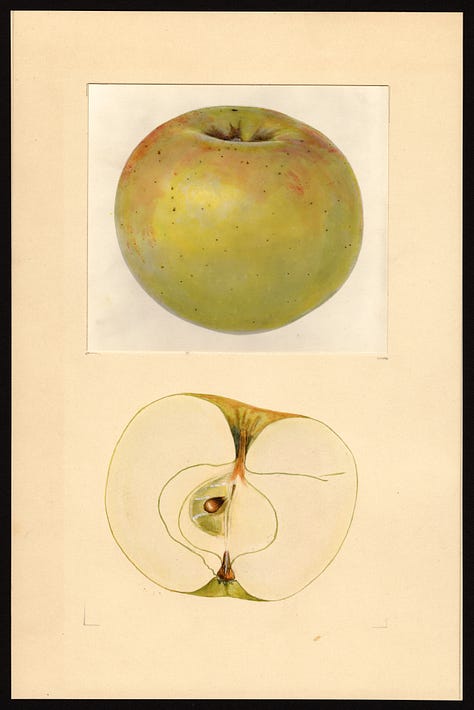
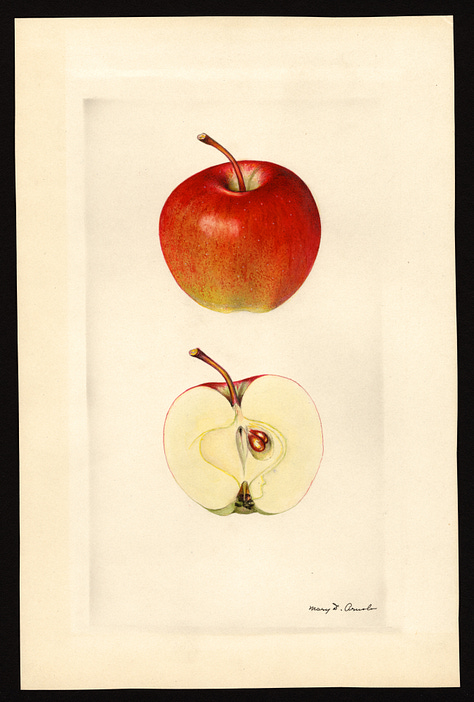
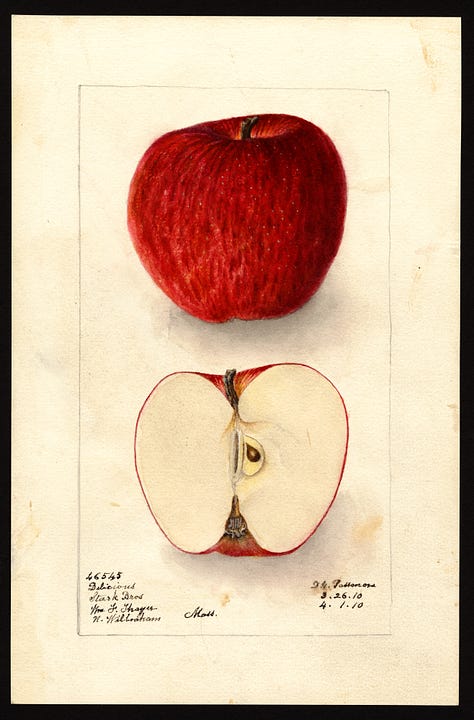
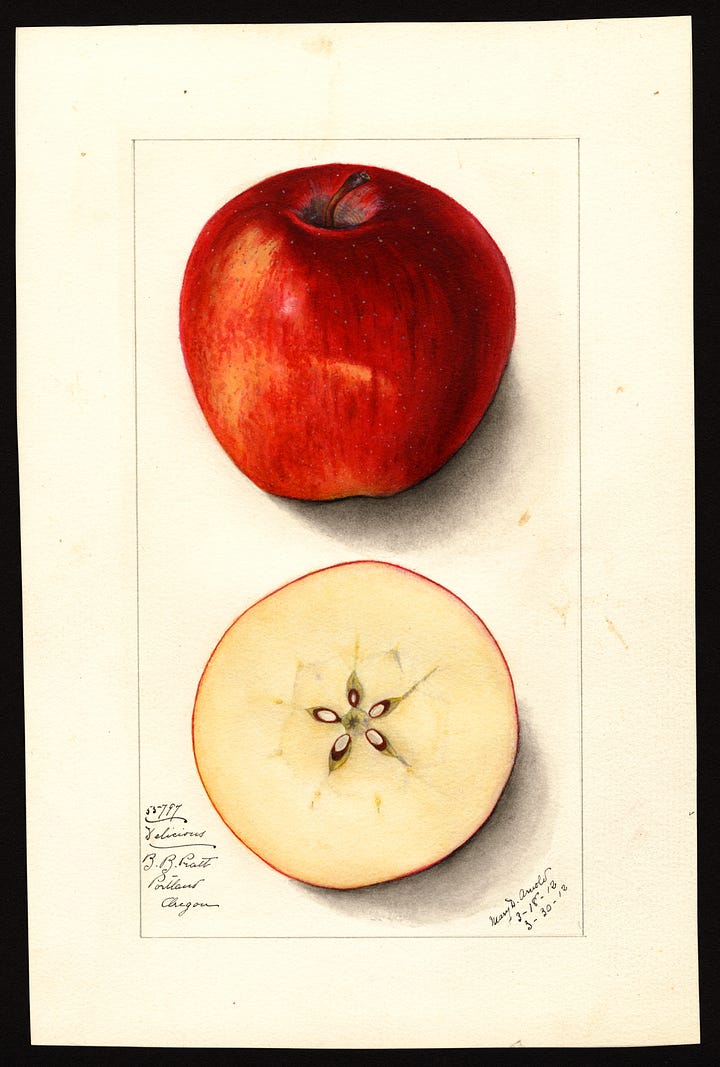
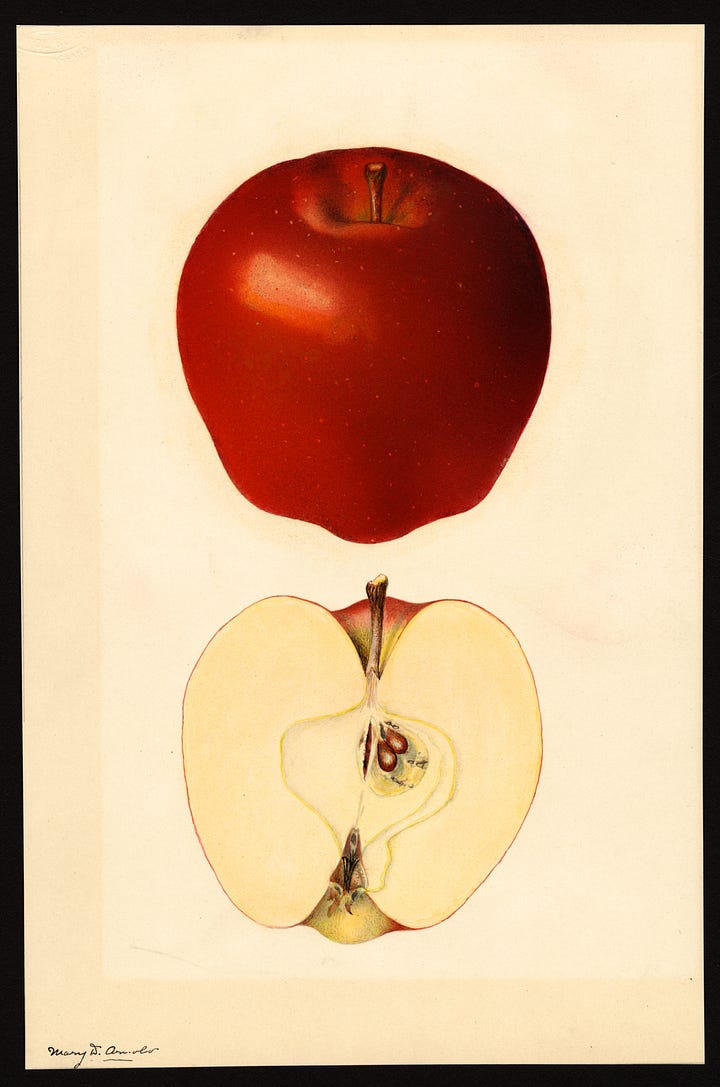
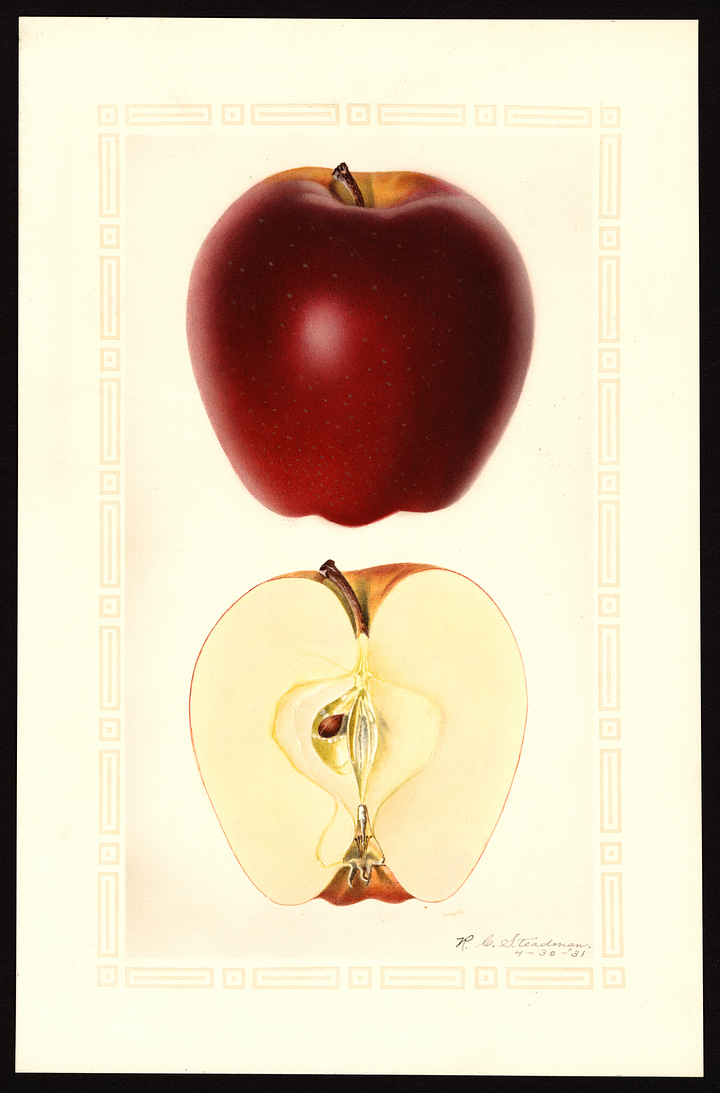
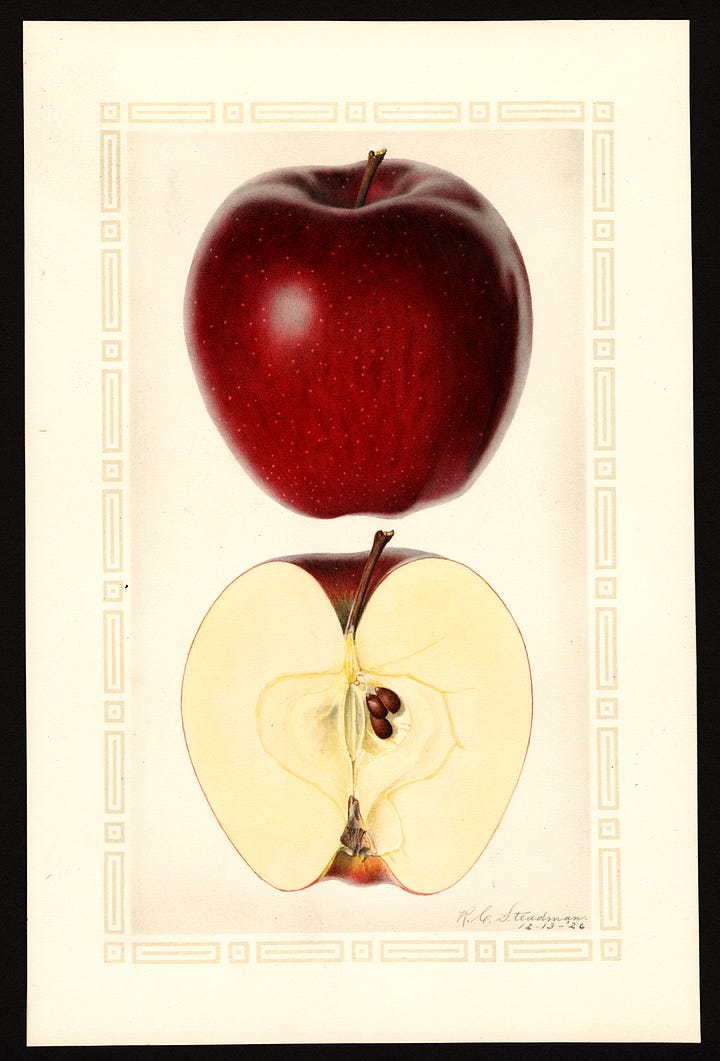
IV. The Reckoning
The pair dominated American orchards for decades. By the 1980s the Red Delicious accounted for three-quarters of Washington's crop, millions of trees bearing Snow White fruit that looked perfect and tasted like mealy wet cardboard. Eventually the market rebelled as novel cultivars emerged from breeding programs and distant shores. These new arrivals, the Gala from New Zealand, the Honeycrisp from Minnesota, the Fuji from Japan (an offspring of the Red Delicious), could store well and actually tasted decent to boot.
Growers lost $800 million as customers abandoned the dynasty that had ruled grocery stores for half a century. The US government stepped in with a $138 million bailout, the largest in agricultural history. The dethroning was complete when the Gala overtook the Red Delicious in sales in 2018, ending an empire built on the premise that appearance could replace substance.
Nobody really eats Red Delicious apples by choice anymore. Yet they persist in the shadowlands of American food. In hospitals and schools, and food banks and hotel continental breakfasts alongside powdered eggs and rubbery bacon and orange juice concentrate. These are the places where people have little say in what they eat, where institutional purchasing decisions determine what passes as food. Tearing out and replanting orchards at scale is expensive, and the government doesn't much care what their bulk food purchases taste like.
You'd be hard-pressed to find a newly planted Red Delicious orchard these days. But something of that old Quaker’s original vision persists, planted by orchardists who appreciate heirloom fruit. And Clay County West Virginia has not forgotten its place as the homeland of the Golden Delicious. They still grow the real thing there and celebrate with an apple festival dedicated to it every September, remembering that real fruit grows from a particular place and has a particular biography, and that these facets of its character can never be industrialized.




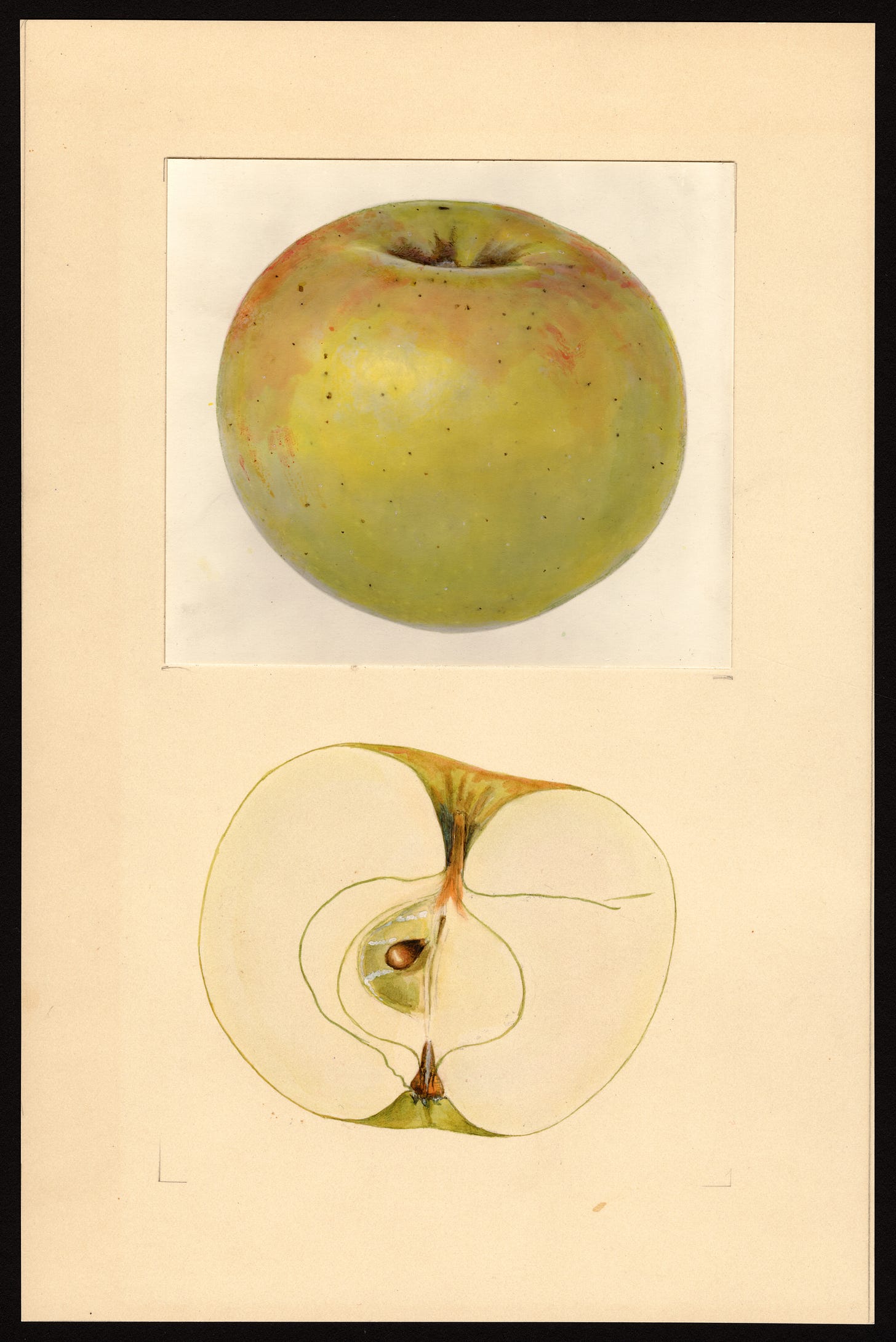


I count the first time I tasted an apple besides Red Delicious was a formative experience in my childhood. That one bite (it was probably a Fuji) taught me the folly of judging solely on appearance, the madness of crowds, and the spectrum of flavors that come from nature.
I do still love a golden delicious when well-ripened, though.